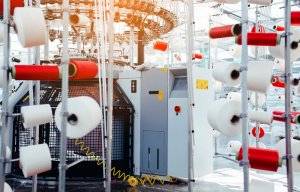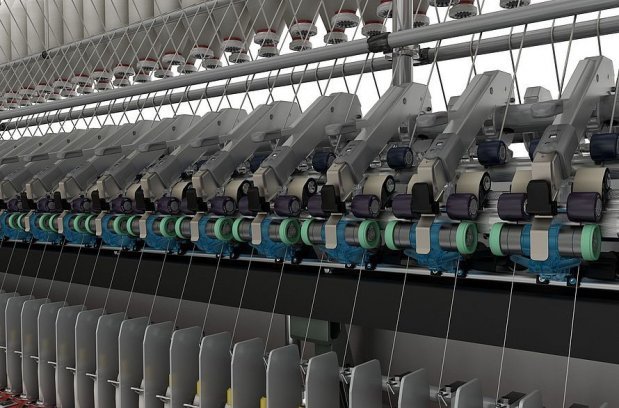
Circular knitting machine shipments buck trend in 2020
Global textile machinery shipments fall in 2022, whilst shipments of spinning spindles rise significantly.

6th July 2023
Knitting Industry
|
Zürich, Switzerland
Shipments of new textile machinery decreased in most segments in 2022, except in spinning. In 2022, global shipments of new short-staple spindles, open-end rotors, and long-staple spindles rose by 27%, 85%, and 195%, respectively (year-on-year). Deliveries of draw-texturing spindles decreased by 13% and the number of shipped shuttle-less looms dropped by 23%. Shipments of large circular knitting machines declined by 27% and shipped flat knitting machines registered a 24%-reduction. The sum of all deliveries in the finishing segment decreased by 28% on average.
These are the main results of the 45th annual International Textile Machinery Shipment Statistics (ITMSS) just released by the International Textile Manufacturers Federation (ITMF). The report covers six segments of textile machinery, namely spinning, draw-texturing, weaving, large diameter circular knitting, flat knitting, and finishing. A summary of the findings for each category is presented below. The 2022 survey was compiled in cooperation with more than 200 textile machinery manufacturers representing a comprehensive measure of world production.
Spinning machinery
The total number of shipped short-staple spindles increased by 2.1 million units in 2022 to a level of 9.76 million. Most of the new shipments went to Asia & Oceania (86%) where deliveries increased by 21% compared to 2021.
Europe (including Turkiey) and America, North, rank 2nd and 3rd with respect to new deliveries. While levels remained relatively small in Africa, the region ranked 4th and experienced the strongest surge in year-on-year shipments with a 290% increase (primarily going to Egypt). The six largest investors in the short-staple segment were China, India, Bangladesh, Pakistan, Turkey, and Uzbekistan.
1.28 million open-end rotors were shipped worldwide in 2022. This represents 587 thousand additional units compared to 2021. 87% of global shipments went to Asia & Oceania where deliveries increased by 91% to 1.1 million rotors. China, India, and Turkey were the world’s three largest investors in rotors and saw investments surging by 67%, 261% and 91%, respectively.
Deliveries of rotors rose in all major destination countries except for Vietnam and Brazil, the 7th and 8th largest destinations in 2022, where shipment of rotors decreased by 34% and 30% compared to 2021 (totalling around 15 thousand units in each case).
Global shipments of long-staple (wool) spindles increased from 31.6 thousand in 2021 to 93,000 in 2022 (up 195%). This effect was mainly driven by a rise in deliveries to Asia & Oceania with a 435% increase in investment. 21% of total deliveries were shipped to China, 20% to Uzbekistan, and 15% to Iran.
Texturing machinery
Global shipments of single heater draw-texturing spindles (mainly used for polyamide filaments) decreased by 14% from nearly 75,100 units in 2021 to 64,400 units in 2022. With a share of 95%, Asia & Oceania remained the strongest destination for single heater draw-texturing spindles in 2022. China, Turkey, and Japan were the three main investors in this segment with a share of 84%, 3.5%, and 2.3% of global deliveries, respectively.
In the category of double heater draw-texturing spindles (mainly used for polyester filaments), global shipments decreased by 13% to a level of 756 thousand spindles. Asia’s share of worldwide shipments remained at 95% and China continued to be the world’s largest investor, accounting for 86% of global shipments.
Circular and flat knitting machinery
Global shipments of large diameter circular knitting machines declined by 27% to 28,651 units in 2022. Asia & Oceania was the world’s leading investor in this category with 77% of global shipments. China was the favoured destination with 45% of all deliveries (i.e., 9930 units) despite a decrease of 55% compared to 2021. India and Bangladesh ranked second and third destinations with 3105 and 2644 units, respectively.
In 2022, the number of shipped electronic flat knitting machines decreased by 24% to 72,600 machines. Asia & Oceania was the main destination for such machines with a share of 83% of world shipments. China remained the world’s largest investor with a 63% share of total shipments despite a 41%-decrease in investment. Shipments to the country dropped from 67,700 units in 2021 to 39,000 units in 2022.
Finishing Machinery
In the ‘fabrics continuous’ segment, the number of shipped stenters decreased by 35% from 2750 units in 2021 to 1780 units in 2022. This number includes an estimate for the total number of stenters shipped by companies which have not participated to the ITMF survey to better grasp the global market size for finishing machinery.
Participating companies reported a decrease in all other machine categories covered in the report (between -2.5% for Relax Dryers / Tumblers and -81% for Bleaching-Line), with exception of Singeing Line which grew from 4 to 22 units. In the ‘fabrics discontinuous’ segment, the number of shipped ‘jigger dyeing / beam dyeing’ and ‘air jet dyeing’ declined by 35% and 45% to 707 units and 675 units, respectively. In 2022, deliveries in the categories ‘overflow dyeing’ increased by 4% to 1714 units.
Weaving Machinery
In 2022, global shipments of shuttle-less looms decreased by 23% to 114 thousand units. Deliveries in the categories ‘air-jet’ and ‘waterjet’ dropped by 13% and 38,4% to 39,300 and 46,600 looms, respectively. The number of ‘rapier and projectile’ looms rose by 5.3% to 28,300 units. The main destination for shuttle-less looms in 2022 was Asia & Oceania with 93% of worldwide deliveries. 95%, 85%, and 97% of global air-jet, rapier/projectile, and water-jet looms were shipped to that region, respectively. The main investor for air-jet and water-jet looms was China. The main investor for rapier-and-projectile looms was India with 11,400 units (a 70% increase compared to 2021).

Business intelligence for the fibre, textiles and apparel industries: technologies, innovations, markets, investments, trade policy, sourcing, strategy...
Find out more